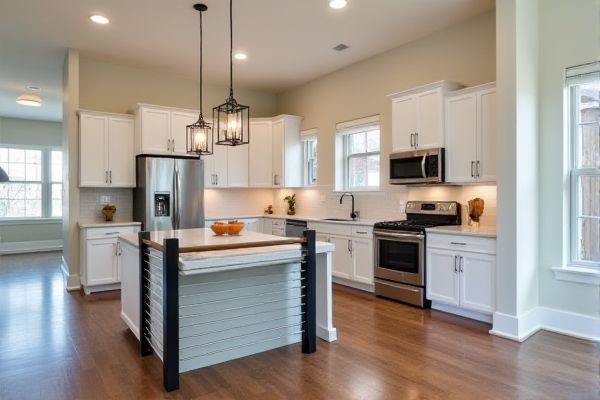
Steel balusters offer a sleek, sturdy, and low-maintenance option with a classic look, while cable railing provides a modern, open view with superior visibility and minimal obstruction. Discover which railing type best suits Your design and safety needs by reading the full comparison in the article.
Table of Comparison
| Feature | Steel Baluster | Cable Railing |
|---|---|---|
| Material | Steel (galvanized, powder-coated) | Stainless Steel Cables |
| Durability | High, rust-resistant with coating | Very High, stainless steel resists corrosion |
| Maintenance | Low, occasional cleaning and repainting | Low, requires periodic tension adjustments |
| Appearance | Solid, classic and modern look | Minimalist, sleek, and open view |
| Safety | Strong vertical support, code-compliant | Strong horizontal cables, must meet tension standards |
| Installation Complexity | Moderate, requires precise spacing | Moderate to high, needs specialized tools for tensioning |
| Cost | Moderate to high depending on finish | Moderate to high, varies with cable gauge and fittings |
| Typical Uses | Residential and commercial staircases, balconies | Decks, patios, modern architectural designs |
Overview: Steel Baluster vs Cable Railing
Steel balusters offer a sturdy, classic look with vertical metal rods that provide strong support and durability for staircases and decks. Cable railing features thin, horizontal stainless steel cables that create a modern, minimalist appearance while maximizing visibility and airflow. Both options provide safety and longevity, with steel balusters emphasizing traditional aesthetics and cable railing highlighting contemporary, open designs.
Aesthetic Differences Between Steel Baluster and Cable Railing
Steel balusters offer a classic, solid appearance with clean vertical lines that enhance traditional or modern architectural styles, providing a bold, substantial visual impact. Cable railing features thin, horizontal stainless steel cables that create an unobstructed, minimalist look, ideal for contemporary designs while maximizing views and natural light. The choice between steel baluster and cable railing hinges on whether a sleek, open aesthetic or a more defined, structured look aligns with the design intent.
Durability and Strength Comparison
Steel balusters offer exceptional durability and strength due to their solid metal construction, providing robust support and resistance to heavy loads and impacts. Cable railing, while flexible and aesthetically appealing, generally relies on tensioned stainless steel cables that are strong but may require more frequent maintenance to retain optimal tension and prevent sagging. Steel balusters withstand harsh weather conditions and corrosion more effectively, making them ideal for long-term structural integrity in exterior applications.
Installation Process and Complexity
Steel baluster installation involves precise measurements, drilling, and securing individual vertical posts, requiring moderate expertise and specialized tools to ensure alignment and stability. Cable railing systems necessitate tensioning stainless steel cables between posts, demanding careful calibration to achieve proper tautness and avoid sagging, which can increase the complexity and installation time. Your choice impacts labor intensity and skill level, as steel balusters offer straightforward installation, whereas cable railings require experience with cable tensioning for optimal results.
Maintenance Requirements for Each Option
Steel balusters require minimal maintenance, with occasional cleaning and rust prevention treatments to keep them looking pristine and structurally sound. Cable railing needs regular tension adjustments and cleaning to prevent corrosion on the cables, especially in coastal or humid environments. Your choice depends on how much time you're willing to invest in upkeep, with steel offering durability and cable requiring more hands-on care to maintain safety and appearance.
Cost Analysis: Steel Baluster vs Cable Railing
Steel balusters typically cost between $25 to $40 per linear foot, offering a durable and low-maintenance option that suits various architectural styles. Cable railing systems range from $40 to $60 per linear foot due to their complex installation and materials like stainless steel cables, making them a more expensive choice. Your decision should weigh initial investment against long-term durability and aesthetic preferences for cost-effective railing solutions.
Safety Considerations and Building Codes
Steel balusters provide exceptional strength and rigidity, meeting stringent building codes that require solid barriers to prevent falls, especially in residential and commercial staircases. Cable railing, while modern and aesthetically pleasing, must use high-tension cables and closely spaced posts to comply with safety regulations that prevent children or objects from passing through gaps. Both systems require adherence to International Building Code (IBC) and local regulations, ensuring minimum height requirements and load resistance for safe use.
Indoor vs Outdoor Applications
Steel balusters offer superior durability and resistance to corrosion, making them ideal for both indoor and outdoor applications where weather exposure is a concern. Cable railings provide a modern aesthetic and excellent visibility, suited for outdoor decks and balconies but may require more maintenance to prevent cable slack or rust in harsh climates. Indoor installations benefit from steel balusters' sleek look and low upkeep, while cable railings enhance open sightlines and natural light flow in interior staircases and lofts.
Customization and Design Flexibility
Steel balusters offer extensive customization options including various shapes, sizes, and finishes, allowing for a tailored aesthetic that suits both traditional and modern architectural styles. Cable railing provides design flexibility with sleek, horizontal lines that create an open, unobstructed view, often preferred for contemporary settings and outdoor spaces. Both materials enable versatile configurations, but steel balusters excel in ornamental details while cable systems prioritize minimalistic, airy designs.
Pros and Cons Summary
Steel balusters offer superior strength and durability, making them ideal for long-lasting, low-maintenance railing solutions, but they can be more expensive and harder to install compared to cable railing. Cable railings provide a modern aesthetic with excellent visibility and easy installation, though they may require regular tension adjustments and are less robust against impacts. Your choice depends on balancing aesthetic preferences, maintenance willingness, and budget constraints.
 homyna.com
homyna.com